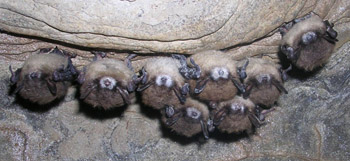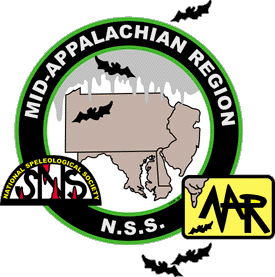Photo Credit: Al Hicks, New York Dept. of Environmental Conservation

First documented during the Winter of 2006-2007 in New York State, White Nose Syndrome, commonly referred to as simply WNS, refers to a white fungus, Pseudogymnoascus destructans, that is easily recognized as a "fuzz", on and around the noses of affected bats. The fungus may be a symptom and not the cause of the mortality observed to date. Bats affected with WNS do not always have the fungus, but may display abnormal behaviors.
To date, it is still unclear of if or how WNS is being transmitted, however it is known that the presence of WNS has been documented at numerous caves and mines and has spread rapidly throughout the Northeast and the eastern half of the United States into the midwest and western reaches of the United States.
As of the Winter 2015-2016 season, WNS has been documented as far south as Missippi and as far west as Washington state and has been confirmed in a total of 28 states within the United States and 5 Canadian provinces. However, the fungus has been primarly found and confirmed within the eastern half of the Unitied States. The fungus Pseudogymnoascus destructans (Pd) has also been found in Europe and China.
Seven North American bat species have been confirmed with WNS, and the fungus has been found on five more. Several species of bat seem resistant to the disease, but some species are seeing mortality of up to 98%. Due to impacts from this disease, the Northern long-eared bat is now protected as Threatened under the Endangered Species Act. Under the final rule documented hibernacula for the species are protected year-round, with incidental take , including unintentional harm or harassment of bats, prohibited within a quarter mile radius of documented hibernacula (sometimes available at the state s Natural Heritage Inventory
database.
The Early Years......
2006-2007
First documented case of WNS was "officially" confirmed in New York (NY).
2007-2008
The surrounding states of Vermont (VT), Massachusetts (MA), and Connecticut (CT), are added to the confirmed cases list
during the Winter of 2007-2008.
2008-2009
Additional documented cases of WNS are reported in Pennsylvania (PA), New Jersey (NJ), New Hampshire (NH), West Virginia (WV), and Virginia (VA), during the Winter of 2008-2009.
2009-2010
New cases of WNS has also been confirmed in caves within the nearby states of Maryland (MD), and Tennessee (TN), as well as within the provinces of Ontario (ON), and Quebec (QC), Canada, during the Winter of 2010.
2010-2011
During the Winter of 2011, new documented cases of WNS have been "officially" confirmed in the states of Indiana (IN), Ohio (OH), North Carolina (NC), Kentucky (KY), and Maine (ME), as well as within the provinces of Nova Scotia (NS), and New Brunswick (NB), Canada.
2011-2012
The state of Alabama (AL) is added to the list of states with confirmed WNS cases in March 2012. Of significance, is that Alabama was belived to be far enough south that the WNS would not effect bats. That theory was proved wrong! Currently, Alabama is the most southern most extent within the Unites States of the effects of WNS.
WNS has also been confirmed for the first time to have crossed the Mississippi River and have effected bats in the state of Missouri (MO). Currently, Missouri is along the western border of the primary effected area of the eastern half of the United States to have confirmed cases of WNS.
Back East, the little state of Delaware (DE) is inevitably added to the list of states with confirmed cases of WNS.
2012-2013
Illinois (IL) becomes the 20th U.S. state to confirm the presence of WNS in bats. In the eastern maritime region of Canada, the province of Prince Edward Island (PEI) confirms cases of WNS in February 2013 and becomes the last province within the maritime region to report cases of WNS.
In the southern portion of the United States, the disease continued to spread on the front lines of the large affected area into the states of Georgia (GA) and South Carolina (SC).
Also, during the Winter of 2013, Mammonth Cave National Park, located in south central Kentucky, becomes the ninth national park within the Unites States to have confirmed cases of WNS.
2013-2014
During the Winter season, new documented cases of WNS have been "officially" confirmed in the states of Arkansas (AR) and Wisconsin (WI). Mississippi (MS) becomes the 25th U.S. state to confirm the presence of WNS in bats.
2014-2015
On the western front of the WNS area, the states of Oklahoma (OK) and Iowa (IA) become the 26th and 27th states, respectively, with confirmed cases of WNS.
2015-2016
On March 31, WNS has officially been confirmed in the state of Washington, making the fungus Pseudogymnoascus destructans (Pd) now present on the west coast of United States.
The state of Minnesota (MN) also reports confirmed cases of WNS.
2016-2017
Back in the mid-west, Nebraska (NB) becomes the 30th state to have confirmed cases of WNS. Suspected cases are also pending in the state of Texas (TX) as the fungus has been found on bats there.
2017-2018
Another state within the mid-west, Kansas (NB) becomes the 31st state to have confirmed cases of WNS. Suspected cases continue in the state of Texas (TX) but are still not confirmed.
*** The following "confirmed" cases above are derived from the "White Nose Syndrome (WNS) Occurrence Map", dated March 20, 2020, PA Game Commission, on behalf of the National Speleological Society (NSS) Liaison on White Nose Syndrome.
Note: Considering that the Mid-Appalachian Region (MAR) is an internal organization of the National Speleological Society (NSS), and that the NSS maintains its own special "up-to-date" section of WNS with the latest information, it is not the MAR's intention for this page to explain the latest developments of WNS, but rather to act as a portal from which a viewer can access additional information.
Please 'click' on the button below to access the "Official" National Speleological Society's section on White Nose Syndrome.

| 






